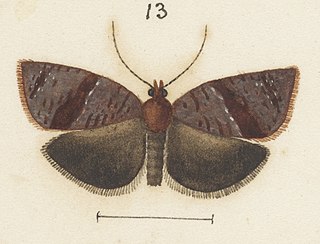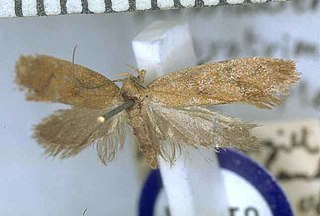Hygroplasta is a genus of moths in the family Lecithoceridae.

Asterivora colpota is a moth in the family Choreutidae. It was first described by Edward Meyrick in 1911. It is endemic to New Zealand and is found throughout the North and South Islands. It is regarded as a lowland species and adults are on the wing from November until March. This moth has been collected by beating shrubs.

Epichorista eribola is a species of moth of the family Tortricidae. It is endemic to New Zealand and has been collected on the Westcoast of the South Island. The adults of this species are on the wing in January and inhabit damp forests.

Epichorista aspistana is a species of moth of the family Tortricidae. It is endemic to New Zealand and has been collected in Canterbury and Otago. This species inhabits moist grassy areas at altitudes ranging from sea level to 1650m. Larvae feed on species within the genus Acaena. Adults are on the wing in November to February.

Pyrgotis eudorana is a species of moth of the family Tortricidae. It is endemic in New Zealand and has been observed in both the North and South Islands. However it is regarded as a rare insect. This species inhabits native forest. Larvae exclusively feed on Muehlenbeckia australis and adults are on the wing from November to April. Adults are attracted to light.
Brachmia custos is a moth in the family Gelechiidae. It was described by Edward Meyrick in 1911. It is found in southern India.
Parapsectris tholaea is a moth in the family Gelechiidae. It was described by Edward Meyrick in 1911. It is found in South Africa, Namibia and Zimbabwe.
Stomopteryx circaea is a moth of the family Gelechiidae. It was described by Edward Meyrick in 1911. It is found in South Africa.
Carodista paroristis is a moth in the family Lecithoceridae. It was described by Edward Meyrick in 1911. It is found in Sri Lanka.
Nosphistica erratica is a moth in the family Lecithoceridae. It was described by Edward Meyrick in 1911. It is known from Sri Lanka.
Lecithocera fornacalis is a moth in the family Lecithoceridae. It was described by Edward Meyrick in 1911. It is found in Sri Lanka.
Lecithocera puteolata is a moth in the family Lecithoceridae. It was described by Edward Meyrick in 1911. It is found in southern India.
Lecithocera officialis is a moth in the family Lecithoceridae. It was described by Edward Meyrick in 1911. It is found in South Africa.
Hygroplasta monodryas is a moth in the family Lecithoceridae. It was described by Edward Meyrick in 1914. It is found in southern India.
Thubana isocrypta is a moth in the family Lecithoceridae. It was described by Edward Meyrick in 1911. It is found in Sri Lanka.
Torodora metasaris is a moth in the family Lecithoceridae. It was described by Edward Meyrick in 1911. It is found in Assam, India.
Torodora thraneuta is a moth in the family Lecithoceridae. It was described by Edward Meyrick in 1911. It is found in Sri Lanka.
Torodora typhlopis is a moth in the family Lecithoceridae. It was described by Edward Meyrick in 1911. It is found in southern India.

Tingena paratrimma is a species of moth in the family Oecophoridae. It is endemic to New Zealand and has been observed in the lower parts of the South Island. George Hudson regarded this species are uncommon. The adults of this species are on the wing from November to February.

Trachypepla ingenua is a moth of the family Oecophoridae first described by Edward Meyrick in 1911. It is endemic to New Zealand and has been collected in both the North and South Islands. This species is one of the larger in the genus Trachypepla and the colouration of the adults imitates bird droppings. The preferred habitat of T. ingenua is native forest and adults are on the wing from December to February.





